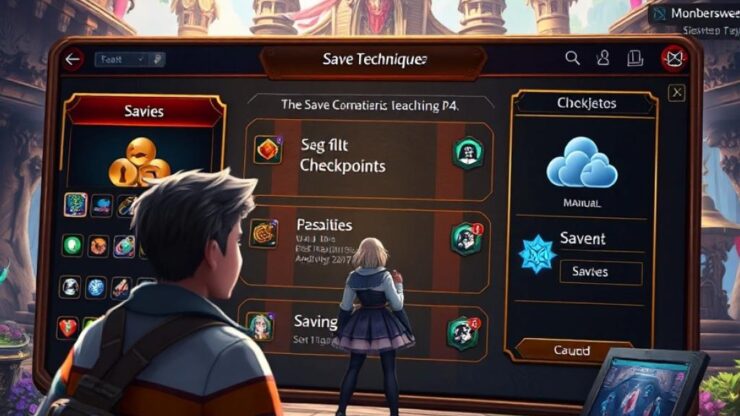Effective Save Point Management

Understanding the Importance of Save Points
In the realm of video games, save points serve as critical junctures that allow players to secure their progress and mitigate the risk of losing hard-earned achievements. Effective management of these save points not only enhances the gaming experience but also alleviates frustration caused by unexpected setbacks. Understanding the nuances of save point mechanics can empower players to make informed decisions, ultimately leading to a more enjoyable and rewarding gameplay experience.
Strategies to Optimize Save Point Usage
Players often overlook the strategic implications of save points, leading to potential regrets during challenging gameplay. Employing a few well-thought-out strategies can significantly improve your save point management:
- Frequent Saves: Make a habit of saving your progress at regular intervals, especially before entering challenging areas or engaging in boss fights.
- Differentiating Save Files: Create multiple save files to safeguard against potential game-breaking bugs or narrative branches that may not align with your expectations.
- Utilizing Auto-Save Features: Familiarize yourself with your game’s auto-save mechanisms to ensure that you’re never too far removed from your last save.
Analyzing Save Point Mechanics Across Genres
Different gaming genres exhibit distinct save point systems, which can influence how players approach their gameplay. Below is a comparative analysis of save point mechanics across various genres:
| Genre | Save Point Type | Player Strategy |
|---|---|---|
| RPG | Manual and Auto-Save | Utilize both methods to preserve character development |
| Action/Adventure | Checkpoint System | Save before major encounters or puzzles |
| Platformer | Stage-based Save Points | Complete sections before saving |
| Survival | Limited Save Opportunities | Plan saves for critical resource management |
Utilizing Cloud Saves for Cross-Platform Play
The Evolution of Save Systems
In an era where gamers traverse multiple platforms, the concept of cloud saves has revolutionized the way we manage our game progress. Gone are the days of being tethered to a single console or device; with cloud saves, players can seamlessly switch from their PC to their console or even mobile devices without missing a beat. This flexibility not only enhances convenience but also invites a new level of strategy in how we approach our gaming sessions.
Benefits of Cloud Saving Mechanisms
One of the most significant advantages of utilizing cloud saves is the security they provide. By storing your progress online, you minimize the risk of losing data due to hardware malfunctions or accidental deletions. Additionally, cloud saves facilitate a more fluid gaming experience. For instance, if a player enjoys a game on their console but wishes to continue the adventure while traveling, they can effortlessly pick up where they left off on a portable device. This aspect is particularly appealing for those who engage in lengthy RPGs or expansive open-world games, where immersion is key.
Cross-Platform Compatibility: The Future of Gaming
As gaming technology continues to evolve, the importance of cross-platform play cannot be overstated. Cloud saves enable players to not only maintain progress across different systems but also to participate in multiplayer experiences regardless of their platform. This connectivity fosters a more inclusive gaming community, allowing friends to team up or compete no matter where they are playing. However, it’s essential for players to familiarize themselves with the specific cloud saving options available for each game, as some titles may have unique requirements or limitations. Understanding these factors can significantly enhance the gaming experience, preventing frustrating situations where progress cannot be accessed. Ultimately, leveraging cloud saves is not just a matter of convenience; it’s a strategic advantage in maximizing your gaming potential.
The Importance of Manual Saves
In the dynamic world of video gaming, the ability to control your save progress remains a cornerstone of the player experience. While modern gaming has introduced numerous automated systems to aid in progress retention, there’s an undeniable value in the practice of manual saves. This technique empowers players to take charge of their journey, ensuring that every victory, every exploration, and every significant decision is securely stored at their discretion.
Manual saves offer a layer of security that auto-save features cannot always provide. Players often face unexpected challenges, whether they be formidable bosses or intricate puzzles that require multiple attempts. By making a conscious effort to save manually before these pivotal moments, players can avoid the frustration of replaying extensive segments of the game. This practice not only protects against unforeseen mishaps but also allows for a tailored approach to gameplay, where players can experiment with different strategies without the fear of permanent setbacks.
Furthermore, the emotional investment in a game’s narrative can be deeply intertwined with the act of saving. Every manual save represents a milestone, a moment worth remembering. This connection to the game enhances the overall immersion, creating a more personal experience as players reflect on their journey. The act of choosing when to save can also serve as a strategic tool, especially in RPGs where player choices can lead to multiple outcomes. By saving at critical junctions, players can explore various storylines without being locked into a single path.
As the gaming landscape continues to evolve, it’s essential to recognize the complementary nature of both manual and auto-saves. While the latter provides convenience, the former offers a personalized touch that can enrich the gameplay experience. In conclusion, understanding the significance of manual saves not only prepares players for challenges ahead but also deepens their connection to the games they love, making every save a testament to their unique journey.
Understanding Auto-Save Features
The evolution of gaming has brought with it a myriad of save mechanisms, among which auto-save features stand out due to their convenience and efficiency. Players often find themselves in the heat of action, and the last thing they want to worry about is preserving their progress. Auto-save systems eliminate that concern, automatically recording a player’s advancements at designated intervals. However, while these systems enhance gameplay fluidity, understanding their intricacies can significantly elevate a player’s overall experience.
Auto-save features vary widely across different gaming genres, and their implementation can greatly affect how players approach challenges. For instance, in open-world games, auto-saves might occur after every major event or discovery, allowing players to explore without the burden of manual saves. In contrast, action games may employ more stringent auto-save points, often only triggering during significant plot advancements or after defeating a boss. This variability necessitates a nuanced understanding of how auto-saves function within each game, as relying solely on them can lead to unforeseen setbacks.
Recognizing the Triggers of Auto-Save
To fully leverage auto-save functionality, players must first recognize when these saves occur. Typically, auto-saves are triggered by specific actions, such as completing quests, entering new areas, or defeating enemies. Understanding these triggers can help players navigate their gameplay more strategically. For example, if a player knows that crossing a threshold will trigger an auto-save, they might choose to pause and prepare for upcoming challenges, ensuring they are adequately equipped before proceeding.
Avoiding Common Pitfalls of Auto-Save
While auto-saves are designed to be helpful, they can sometimes lead to complications if not properly understood. One of the most common pitfalls is assuming that an auto-save has occurred before a critical moment, such as an intense battle or a significant narrative choice. This assumption can result in frustration if a player encounters an unexpected defeat and realizes they have not saved in a while. To mitigate this risk, players should develop a habit of checking recent save timestamps when possible and supplementing auto-saves with manual saves during pivotal moments. This dual approach ensures a comprehensive safety net, ultimately enhancing the gaming experience.
In conclusion, while auto-save features are an invaluable tool in modern gaming, their effectiveness is maximized when players understand their mechanics and limitations. By recognizing triggers and avoiding common pitfalls, gamers can navigate their adventures with confidence, ensuring that every thrilling moment is securely captured.
Best Practices for Backup Saves
In the intricate world of gaming, where every decision can lead to unforeseen consequences, the significance of backup saves cannot be understated. These additional layers of security ensure that players can recover from mistakes or unexpected game failures, preserving hard-earned progress. As games grow increasingly complex and narratives more intricate, understanding how to effectively implement backup saves becomes essential for every gamer.
Establishing a Robust Backup System involves more than simply creating duplicate save files; it requires a thoughtful approach to your gaming strategy. Players should consider how often they engage with critical moments in their journey. For instance, saving your progress before entering a new area or attempting a challenging boss fight is vital. This practice not only mitigates the risk of losing progress but also allows for experimentation with different gameplay strategies. Backup saves act as a safety net, enabling players to explore various outcomes without the fear of permanent failure.
Moreover, leveraging multiple save slots can be a game-changer. Rather than relying on a single save file, gamers should take advantage of the ability to create several backups. This way, if one file becomes corrupted or if a player wishes to revisit an earlier part of the game, they have the flexibility to do so. It is particularly beneficial in narrative-driven games where decisions can lead to divergent paths. By maintaining distinct save files at different stages, players can effortlessly navigate the rich tapestry of stories that modern games offer.
Utilizing External Storage Solutions can further enhance your backup strategy. While cloud saves offer convenience, having a physical backup on an external hard drive or USB can provide peace of mind. In the event of internet outages or platform-specific issues, having your saves stored offline ensures that your progress remains secure. Players should also make it a habit to regularly transfer their save data to external storage, creating a comprehensive archive of their gaming achievements.
In conclusion, the implementation of effective backup save practices is paramount in today’s gaming landscape. By establishing a robust backup system, leveraging multiple save slots, and utilizing external storage solutions, players can enjoy their gaming experiences with confidence, knowing that their progress is safeguarded against the unexpected.
Disclaimer
This article has been created or edited with the support of artificial intelligence and is for informational purposes only. The information provided should not be considered investment advice. Please seek the support of a professional advisor before making any investment decisions.






